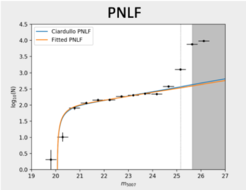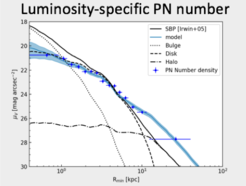The survey of planetary nebulae in Andromeda (M31). I. Imaging the disc and halo with MegaCam at the CFHT
Bhattacharya, S., Arnaboldi, M., Hartke, J., Gerhard, O., Comte, V., McConnachie, A., et al., 2019, A&A, 624, A132
The Andromeda (M31) galaxy subtends nearly 100 sq. deg. on the sky, with severe contamination from the Milky Way halo stars whose surface density displays a steep gradient across the entire M31 field-of-view. Planetary Nebulae (PNe) are a population of stars in the late stages of stellar evolution, that are firmly associated with M31, and are known to be excellent tracers of light, chemistry and motion in galaxies. We present a 16 sq. deg. survey of the disk and inner halo of M31 with the MegaCam imager at the CFHT to identify PNe, characterize their luminosity-specific PN number and luminosity function (PNLF).

Distribution of Planetary Nebula within the disk of the Andromeda galaxy (M31).
PNe were identified based on their bright OIII 5007 emission and absence of a continuum. Subsamples of the faint PNe were independently confirmed by matching with resolved Hubble Space Telescope sources from the PHAT survey and spectroscopic follow-up observations with HectoSpec@MMT. The current survey reaches 2 mag fainter than the previous most-sensitive survey. We identify 4289 PNe, of which only 1099 were previously known.
By comparing the PN number density with the surface brightness profile of M31 out to ~30 kpc along the minor-axis, we find that the stellar population in the inner halo has a 7 times larger luminosity-specific PN number value than that of the disk. It indicates that the stellar population at deprojected minor-axis radii larger than ~10 kpc is different from that in the M31 disk. We measure the PNLF and find a bright cut-off and a slope consistent with the previous determination by Ciardullo et al. (1989). Interestingly, it shows a significant rise at the faint end, present in all radial bins covered by the survey, much steeper than that observed for the Magellanic clouds and Milky Way bulge. M31 shows two major episodes of star formation and the rise in the faint end of the PNLF is possibly associated with the older stellar population. It may also be a result of varying opacity of the PNe.

Number of Planetary Nebula (logarithmic) against magnitude at a wavelength of 5007Å.



